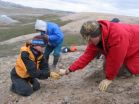(Press-News.org) Sharks were a tolerant bunch some 50 million years ago, cruising an Arctic Ocean that contained about the same percentage of freshwater as Louisiana's Lake Ponchatrain does today, says a new study involving the University of Colorado Boulder and the University of Chicago.
The study indicates the Eocene Arctic sand tiger shark, a member of the lamniform group of sharks that includes today's great white, thresher and mako sharks, was thriving in the brackish water of the western Arctic Ocean back then. In contrast, modern sand tiger sharks living today in the Atlantic Ocean are very intolerant of low salinity, requiring three times the saltiness of the Eocene sharks in order to survive.
"This study shows the Arctic Ocean was very brackish and had reduced salinity back then," said University of Chicago postdoctoral researcher Sora Kim, first author on the study. "The ancient sand tiger sharks that lived in the Arctic during the Eocene were very different than sand tiger sharks living in the Atlantic Ocean today."
The findings have implications for how today's sharks might fare in a warming Arctic region, which is heating up at about twice the rate of the rest of the planet due to increasing greenhouse gases, said CU-Boulder geological sciences Associate Professor Jaelyn Eberle, a study co-author. The potential consequences of warming in the Arctic include changes in freshwater runoff and atmospheric water vapor and decreases in salinity that can affect marine biology and seawater circulation dynamics.
"As more freshwater flows into the Arctic Ocean due to global warming, I think we are going to see it become more brackish," said Eberle, also curator of fossil vertebrates at the University of Colorado Museum of Natural History. "Maybe the fossil record can shed some light on how the groups of sharks that are with us today may fare in a warming world."
A paper on the subject was published online June 30 in the journal Geology. Other co-authors include David Bell from the University of Wyoming, Dewayne Fox from Delaware State University and Aspen Padilla, a CU-Boulder graduate who worked with Eberle as a master's candidate. The study was funded in part by the National Science Foundation.
The new findings on Arctic Ocean salinity conditions in the Eocene were calculated in part by comparing ratios of oxygen isotopes locked in ancient shark teeth found in sediments on Banks Island in the Arctic Circle and incorporating the data into a salinity model. The team also compared its information to prior studies of sediment cores extracted from an oceanic region in the central Arctic Ocean called the Lomonosov Ridge -- a steep hump of continental crust that rises more than 1,000 feet from the ocean floor -- to estimate past environmental conditions in the Arctic Ocean.
"Oxygen isotopes in ancient bones and teeth reflect the water animals are living in or drinking," said Kim, a former postdoctoral researcher at the University of Wyoming. "Because sharks are aquatic, the oxygen from the ocean is constantly being exchanged with oxygen in their body water, and that's what is incorporated into their teeth. When I analyzed their isotopic composition, the numbers seemed weird at first because they indicated an essentially freshwater environment."
The team analyzed 30 fossil sand tiger shark teeth exhumed from Banks Island and 19 modern sand tiger shark teeth from specimens caught in Delaware Bay bordered by Delaware and New Jersey. The paleo-salinity estimate for the modern sand tiger sharks is consistent with the continental shelf salinity present from Delaware south to Florida and from the coastline to roughly six miles offshore, known hunting grounds for modern sand tiger sharks, which have formidable teeth and can reach a length of nearly 10 feet.
The Eocene Epoch, which ran from about 56 to 34 million years ago, was marked by wild temperature fluctuations, including intense greenhouse periods when lush rainforests abounded in the Arctic. Previous studies by Eberle and colleagues showed the fauna there included ancestors of tapirs, hippo-like creatures, crocodiles and giant tortoises. Despite the six months of darkness each year, the terrestrial Arctic climate included warm humid summers and mild winters with temperatures ranging from just above freezing to about 70 degrees Fahrenheit.
"We now know a fair amount about the terrestrial animals and plants that were living in the Eocene Arctic greenhouse period," said Eberle. "To finally get some data on the Eocene marine environment using these shark teeth will help us to begin filling in the gaps."
Eberle said the Eocene Arctic Ocean was largely isolated from the global oceans. "Increased freshwater runoff from the land due to an intensified hydrologic cycle and a humid Arctic would have turned it more brackish pretty quickly," she said.
The salinity gradient across the Eocene Arctic Ocean that provided habitat for the ancient sand tiger sharks also was found to be much larger than the salinity gradient tolerated by modern sand tiger sharks living in the Atlantic Ocean, said Eberle. "The Eocene lamniform group of sharks had a much broader environmental window than lamniform sharks do today."
Eberle and Kim said the early-middle Eocene greenhouse period from 53 to 38 million years ago is used as a deep-time analog by climate scientists for what could happen on Earth if CO2 and other greenhouse gases in Earth's atmosphere continue to rise, and what a "runaway" greenhouse effect potentially could look like.
"Through an analysis of fossil sand tiger shark teeth from the western Arctic Ocean, this study offers new evidence for a less salty Arctic Ocean during an ancient 'greenhouse period,' " says Yusheng "Chris" Liu, program director in the NSF's Division of Earth Sciences, which co-funded the research with NSF's Division of Polar Programs. "The results also confirm that the Arctic Ocean was isolated during that long-ago time."
INFORMATION:
Jaelyn Eberle, CU-Boulder, 303-819-6914
jaelyn.eberle@colorado.edu
Sora Kim, University of Chicago, 773-669-4147
sora@uchicago.edu
Jim Scott, CU-Boulder media relations, 303-492-3114
jim.scott@colorado.edu
New study: Ancient Arctic sharks tolerated brackish water 50 million years ago
2014-06-30
ELSE PRESS RELEASES FROM THIS DATE:
First pediatric autism study conducted entirely online
2014-06-30
UC San Francisco researchers have completed the first Internet-based clinical trial for children with autism, establishing it as a viable and cost effective method of conducting high-quality and rapid clinical trials in this population.
In their study, published in the June 2014 issue of the Journal of the American Academy of Child and Adolescent Psychiatry, the researchers looked at whether an Internet-based trial was a feasible way to evaluate whether omega-3 fatty acids helped reduce hyperactivity in children with autism. The authors found that not only was it a valuable ...
Research proves shock wave from explosives causes significant eye damage
2014-06-30
Researchers at The University of Texas at San Antonio (UTSA) are discovering that the current protective eyewear used by our U.S. armed forces might not be adequate to protect soldiers exposed to explosive blasts.
According to a recent study, ocular injuries now account for 13 percent of all battlefield injuries and are the fourth most common military deployment-related injury.
With the support of the U.S. Department of Defense, UTSA biomedical engineering assistant professor Matthew Reilly and distinguished senior lecture in geological sciences Walter Gray have been ...
Earth-Kind roses analyzed for salt tolerance
2014-06-30
COLLEGE STATION, TX – Earth-Kind® roses are favorites with gardeners and landscapers. Chosen for their superior tolerance to heat, drought, and pests, as well as their outstanding performance in landscapes, Earth-Kind® roses can thrive in most environments, even with limited care. A new study focused on determining the best Earth-Kind® varieties for withstanding the challenges of salt stress.
As alternative water sources such as reclaimed water are becoming more commonly used as irrigation for urban landscapes and agricultural crops, plants are being subjected to higher ...
New method to grow zebrafish embryonic stem cells can regenerate whole fish
2014-06-30
New Rochelle, NY, June 30, 2014—Zebrafish, a model organism that plays an important role in biological research and the discovery and development of new drugs and cell-based therapies, can form embryonic stem cells (ESCs). For the first time, researchers report the ability to maintain zebrafish-derived ESCs for more than 2 years without the need to grow them on a feeder cell layer, in a study published in Zebrafish, a peer-reviewed journal from Mary Ann Liebert, Inc., publishers. The article is available free on the Zebrafish website.
Ho Sing Yee and coauthors from the ...
With climate change, heat more than natural disasters will drive people away
2014-06-30
Although scenes of people fleeing from dramatic displays of Mother Nature's power dominate the news, gradual increases in an area's overall temperature — and to a lesser extent precipitation — actually lead more often to permanent population shifts, according to Princeton University research.
The researchers examined 15 years of migration data for more than 7,000 families in Indonesia and found that increases in temperature and, to a lesser extent, rainfall influenced a family's decision to permanently migrate to another of the country's provinces. They report in the ...
Study of animal urination could lead to better-engineered products
2014-06-30
Sir Isaac Newton probably wasn't thinking about how animals urinate when he was developing his laws of gravity. But they are connected – by the urethra, to be specific.
A new Georgia Institute of Technology study investigated how quickly 32 animals urinate. It turns out that it's all about the same. Even though an elephant's bladder is 3,600 times larger than a cat's (18 liters vs. 5 milliliters), both animals relieve themselves in about 20 seconds. In fact, all animals that weigh more than 3 kilograms (6.6 pounds) urinate in that same time span.
"It's possible because ...
Comparison study of planting methods shows drilling favorable for organic farming
2014-06-30
SALINAS, CA – In the fertile growing regions of the central coast of California, scientists are looking for ways to increase organic production of strawberry and other crops. Because cover crops can provide weed and erosion control, determining the best method for establishing a uniform and dense cover crop stand as soon as possible after planting is a critical first step. The authors of a new study say that determining optimal planting strategies that accelerate cover crop emergence and reduce light penetration to weeds should be a primary focus. Eric Brennan and Jim Leap ...
Surgical treatment for metastatic melanoma of the liver increases overall survival
2014-06-30
CHICAGO (June 30, 2014): Surgical resection markedly improves survival among metastatic melanoma patients whose disease is isolated to a few areas in the liver, according to new study findings published in the July issue of the Journal of the American College of Surgeons. These results mark a departure for melanoma, an aggressive form of skin cancer, that is most often considered fatal once it has spread to the liver and then, not amenable to surgical treatment.
In the past, surgical treatment for liver metastases was not considered an option for most patients, as the ...
In human evolution, changes in skin's barrier set Northern Europeans apart
2014-06-30
The popular idea that Northern Europeans developed light skin to absorb more UV light so they could make more vitamin D – vital for healthy bones and immune function – is questioned by UC San Francisco researchers in a new study published online in the journal Evolutionary Biology.
Ramping up the skin's capacity to capture UV light to make vitamin D is indeed important, according to a team led by Peter Elias, MD, a UCSF professor of dermatology. However, Elias and colleagues concluded in their study that changes in the skin's function as a barrier to the elements made ...
New research study shows huge savings for health care
2014-06-30
DETROIT, Mich., Monday, June 30, 2014 – Recently published findings in Annals of Internal Medicine by Steven Lipshultz, M.D., Wayne State University professor and chair of pediatrics and pediatrician-in-chief at the Children's Hospital of Michigan, part of the Detroit Medical Center, and colleagues could help to reduce health care charges while also protecting childhood cancer survivors from heart ailments caused by drug therapy.
That's the "very exciting and very hopeful" bottom line of the recently published study, said co-author Lipshultz, who has spent more than ...




